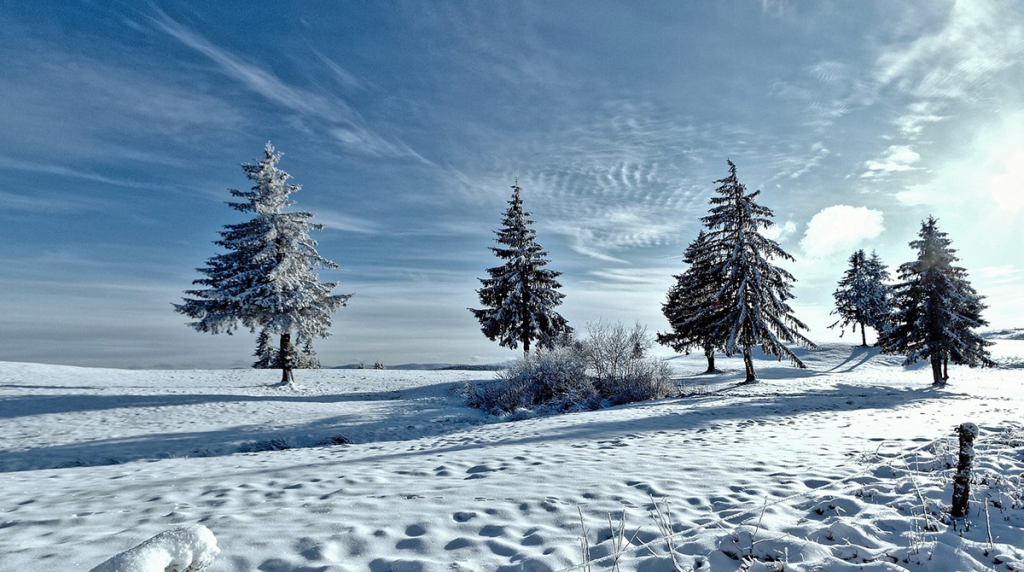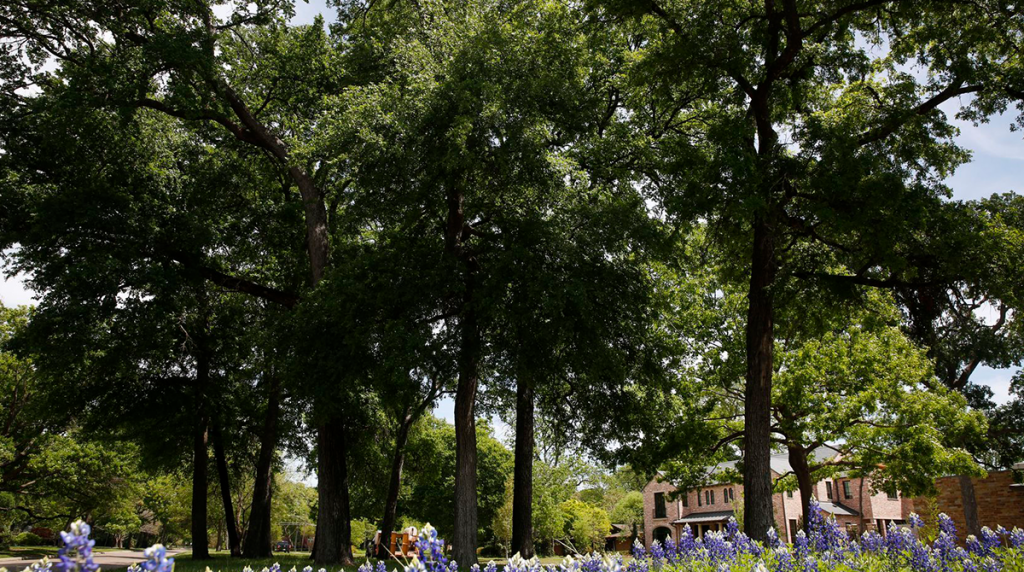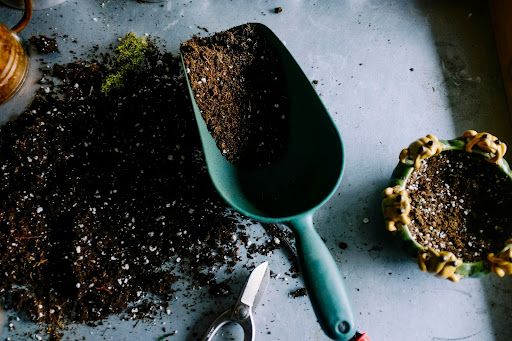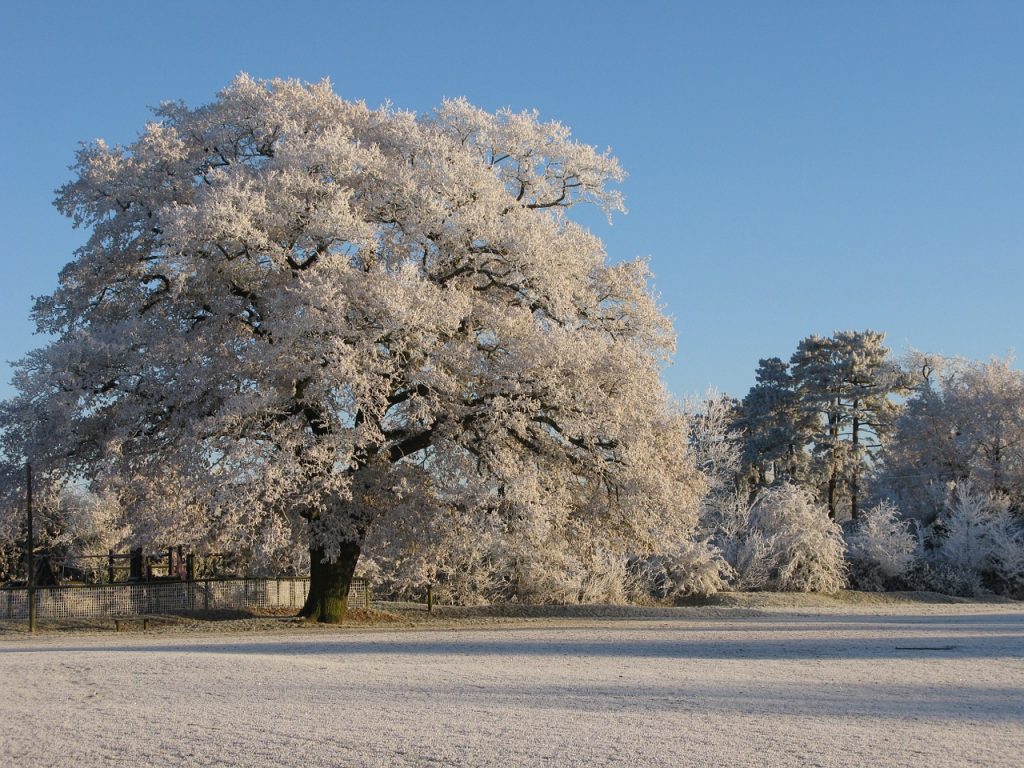
Date December 29, 2020
Category
When springtime comes around each year, everybody wants their yard to bloom into a beautiful, thriving oasis. But before that can happen, their yard has to make it through winter. Many plants and trees, especially native ones, are naturally equipped to handle harsh winter conditions. However, there are some things you can do to better prepare your landscaping for winter weather, especially for the cold, dry winds that we get in North Texas. When the weather outside is frightful, here are some tips to make sure your trees are equipped to handle the winter and delight come springtime.
What happens to trees in the winter?
Winter is an important time for trees. As the daylight hours decline, trees enter a dormant state and lose their leaves to conserve energy and water. From above ground, it might look like they’re too busy resting to do much else, but in reality, many important things are still happening beneath the soil. The underground root systems work year-round to keep the tree’s trunk, branches, and leaves healthy and thriving. During winter, trees continue to grow and collect water and nutrients, storing it up, so they have enough energy to leaf out in the spring. Besides that, winter can also be a reset for some trees that have become insect-infested or overcome by fungus or mold. Although it doesn’t always get cold enough in Texas to kill insects, there are a few types of pests, funguses, and molds that die during the winter, giving your tree a chance to start fresh in the spring.
Pruning and trimming
Winter is the best time for tree maintenance practices like pruning and trimming while the trees are in their dormant state for many trees. Trees spend the entire spring and summer soaking up sunlight and converting it into usable energy through photosynthesis. It takes a lot of that energy to grow leaves and other things the trees might produce, like flowers, nuts, or fruits, depending on the tree type. The recovery from pruning and trimming is easier when the tree is dormant because it can focus more on healing. The cold winter weather also helps protect your trees from infection. A cut in a tree, just like a cut in any living organism, opens it up to the possibility of infection. Harmful microbes and pests take advantage of cuts as an easy opening into the trees. However, many of those pests are dormant during the winter and so less likely to bother your tree while it’s vulnerable. And last but not least, it’s also better to prune or trim your trees in the winter because it’s easier to see the branches when the tree is bare. It’s vital for your tree’s overall health and strength to use the proper techniques when pruning or trimming, so you should consider hiring an arborist. All trees, even healthy mature trees, need to be routinely pruned and trimmed. Our certified arborists are specially trained and available to help you safely and effectively prune trees on your residential or commercial property.
Winter fertilization
You can fertilize your trees any time of the year, but there are certain benefits to choosing to fertilize your trees in fall or winter. We probably don’t have to tell you that summers in Texas are hot and sunny, which makes them very tough on our trees. Summer can deplete the supply of nutrients in your soil, so fertilizing in the fall or winter helps replenish the nutrients your trees need to continue growing through dormancy. In North Texas, the soil doesn’t generally freeze during the winter, which means our trees’ root systems continue to soak in nutrients and water all winter long. If you fertilize your soil in fall or winter, your trees will thank you in the spring when it’s time for them to leaf out or bloom. Their roots will be strong and healthy, and your trees will have plenty of extra food stored for the growing season.
Planting new trees
If you’re thinking about expanding or adding new trees to your landscape, there’s no need to wait until warmer weather. Many people think new trees or saplings won’t withstand winter conditions and assume spring is the ideal time for planting, but there are some definite benefits to planting new trees in the fall or winter. It gives your trees time to spread their roots and grow into their new surroundings before they need to use energy to grow leaves and flowers. The more time you give a tree to establish itself in the soil before spring, the more advantage you give it to succeed in the long-run, especially in Texas, where trees need all the time they can get to prepare for extreme heat and drought conditions during the summer months.
Wrapping
Sometimes trees need a little extra help staying warm enough to survive a cold winter. Most mature trees don’t need assistance, but there are a few cases in which homeowners need to consider wrapping their trees. First, if you plant new trees or have only a few years old, it’s probably best to wrap them during the winter. Second, if you have trees with thin bark, you should consider wrapping their trunks. There are several things you can use for a wrap. Polypropylene fabric is stretchy and durable, making it an ideal candidate. Paper tree wrap or corrugated cardboard also works but must be periodically replaced. You can also use burlap. Most garden stores sell tree wrap. To wrap your tree, start at the bottom of the trunk and wind the tree wrap around the base at a slightly upward angle. It should overlap enough to cover the entire base and be snug, but it shouldn’t be so tight that it chokes the tree.
Mulching in winter
In northern climates where it snows regularly, a blanket of snowfall can act as a protective ground cover against the cold, dry winter air. It can keep the ground underneath moist and warm throughout the winter. However, in North Texas, we rarely see snow, and it never sticks around for long when it does happen. Instead, we have to make our own ground cover to blanket and protect our trees against the elements. The best way to do that is by putting a layer of mulch around the tree. And by that, we mean a small layer. It is possible to use too much mulch and create a “mulch volcano.” Although it might look nice, it can cause many issues in the tree’s root system later on. A flat layer of mulch is best, starting at about three to six inches from the trunk and going outwards in all directions about three feet.
Watering in winter
Trees still need water in winter. In North Texas, our rainy seasons are spring and fall. During the summer and winter, the daily chance of precipitation drops significantly. Of course, it’s easy to remember to water trees in the summer when it’s hot, but it’s important also to remember that the ground can still get very dry during the winter as well, even though it might be cold and gray outside. Be mindful of the amount of precipitation and monitor the ground condition. If the ground is dry, water your trees. They still need water for their roots to grow and collect nutrients.
What to do when a tree is damaged?
Although most trees are well-adapted to make it through the winter just fine, sometimes the elements can be too much for them. It doesn’t often snow in North Texas, but snow or the occasional ice storms we get can be hazardous for trees. When heavy ice or snow collects on top of the tree limbs, sometimes the limbs crack under the weight. Small trees are especially susceptible to winter damage. If it’s possible to brush the snow or ice formations off the branches before they crack, that’s the best way to prevent damage. Older trees are less likely to crack under the weight of snow and ice unless they have weak points. Trees that have been properly pruned will be stronger and therefore hold up better in snow or ice, which is one of the reasons why it’s important to maintain routine tree pruning and trimming, even for healthy trees. If your tree shows signs of storm damage, call a certified arborist tree service as soon as possible. Our ISA Certified Arborists are available to come to your house to make an assessment. Our team members are also expertly trained to handle tree trimming and removal if irreparable storm damage has occurred.
How to tell if your tree is dormant or dead during the winter
All deciduous trees drop their leaves during the winter, so it can be difficult to tell if they are actually dead and need to be removed from the property or if they’re playing possum. There are a few things you can do to check the health of your tree. The first is to check the outside of your tree for signs of life. Dormant trees will still have small leaf buds, which means that your tree is alive and preparing to leaf out in the spring. It would help if you also looked for any signs of sickness. Are there open wounds or large cracks in the trunk of the tree? Is there fungus growing on the branches? If you notice some signs on the outside of the tree that gives you concern about the tree’s health, you can go a little deeper with the twig test or the scratch test. For the twig test, break off a small branch with your fingernail or knife. If it’s brittle and snaps easily, there’s a chance your tree could be dead or dying. Check other parts of the tree because it could be just one branch or section of the tree that’s dead. For a tree that’s alive, the layer under the bark should be green and somewhat moist. That’s where the scratch test comes in handy. You can start by scratching the top layer of bark from the tree’s branches. If it’s green underneath, that’s a good sign. If you can’t reach the tree’s branches, you can scratch the top layer of bark off the trunk. Again, look for green underneath. Like the leaves on a tree, bark replaces itself as it grows. Trees will often shed layers of bark naturally, but if a tree sheds its bark and doesn’t replace it, then that’s cause for concern. If you think your tree might be dead or dying, you must call a certified arborist right away.
TreeNewal can help with your winter tree care.
Winter is an important part of every tree’s natural life cycle. If you have questions about preparing your tree for the harsh winter months or how to care for your tree throughout the winter, we’re here to help. If you have concerns about a tree’s health on your property, please call as soon as possible. We believe strongly in our mission to save trees in North Texas. Our ISA Certified Arborists are always available to answer questions, and we’re happy to make house calls for more serious concerns. We specialize in tree nutrition, tree pruning and trimming, tree removal, root aeration, insect management, disease, and fungus management. We can also handle the fertilization, mulching, or wrapping of your trees. Give us a call at tel:(817) 592-6846 for more information.
To learn more about Arborist Advice: Preparing Your Landscape for Winter, call our Argyle and Southlake based teams
at tel:(817) 592-6846 or send us a message.
We’re a little different than the average tree services company.
Learn more about TreeNewal’s ISA Certified Arborists!
Our Dallas/Fort Worth-based tree doctors can explain how sustainable tree care services add more value to your bottom line.
Healthy trees, healthy lives.








